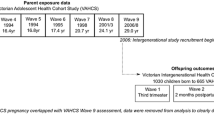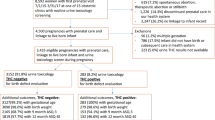Abstract
Cannabis use in pregnancy has increased1,2, and many women continue to use it throughout pregnancy3. With the legalization of recreational cannabis in many jurisdictions, there is concern about potentially adverse childhood outcomes related to prenatal exposure4. Using the provincial birth registry containing information on cannabis use during pregnancy, we perform a retrospective analysis of all live births in Ontario, Canada, between 1 April 2007 and 31 March 2012. We link pregnancy and birth data to provincial health administrative databases to ascertain child neurodevelopmental outcomes. We use matching techniques to control for confounding and Cox proportional hazards regression models to examine associations between prenatal cannabis use and child neurodevelopment. We find an association between maternal cannabis use in pregnancy and the incidence of autism spectrum disorder in the offspring. The incidence of autism spectrum disorder diagnosis was 4.00 per 1,000 person-years among children with exposure compared to 2.42 among unexposed children, and the fully adjusted hazard ratio was 1.51 (95% confidence interval: 1.17–1.96) in the matched cohort. The incidence of intellectual disability and learning disorders was higher among offspring of mothers who use cannabis in pregnancy, although less statistically robust. We emphasize a cautious interpretation of these findings given the likelihood of residual confounding.
This is a preview of subscription content, access via your institution
Access options
Access Nature and 54 other Nature Portfolio journals
Get Nature+, our best-value online-access subscription
$29.99 / 30 days
cancel any time
Subscribe to this journal
Receive 12 print issues and online access
$209.00 per year
only $17.42 per issue
Buy this article
- Purchase on Springer Link
- Instant access to full article PDF
Prices may be subject to local taxes which are calculated during checkout
Similar content being viewed by others
Data availability
The dataset from this study is held securely in coded form at ICES. While data-sharing agreements prohibit ICES from making the dataset publicly available, access may be granted to those who meet prespecified criteria for confidential access, available at https://www.ices.on.ca/DAS. The full dataset creation plan is available from the authors upon request.
References
Corsi, D. J., Hsu, H., Weiss, D., Fell, D. B. & Walker, M. Trends and correlates of cannabis use in pregnancy: a population-based study in Ontario, Canada from 2012 to 2017. Can. J. Public Health 110, 76–84 (2019).
Young-Wolff, K. C. et al. Trends in self-reported and biochemically tested marijuana use among pregnant females in California from 2009–2016. JAMA 318, 2490–2491 (2017).
Volkow, N. D., Han, B., Compton, W. M. & McCance-Katz, E. F. Self-reported medical and nonmedical cannabis use among pregnant women in the United States. JAMA 322, 167–169 (2019).
Jansson, L. M., Jordan, C. J. & Velez, M. L. Perinatal marijuana use and the developing child. JAMA 320, 545–546 (2018).
Richardson, K. A., Hester, A. K. & McLemore, G. L. Prenatal cannabis exposure—the “first hit” to the endocannabinoid system. Neurotoxicol. Teratol. 58, 5–14 (2016).
Correa, F., Wolfson, M. L., Valchi, P., Aisemberg, J. & Franchi, A. M. Endocannabinoid system and pregnancy. Reproduction 152, R191–R200 (2016).
Keimpema, E., Mackie, K. & Harkany, T. Molecular model of cannabis sensitivity in developing neuronal circuits. Trends Pharm. Sci. 32, 551–561 (2011).
Hayes, J. S., Lampart, R., Dreher, M. C. & Morgan, L. Five-year follow-up of rural Jamaican children whose mothers used marijuana during pregnancy. West Indian Med. J. 40, 120–123 (1991).
McLemore, G. L. & Richardson, K. A. Data from three prospective longitudinal human cohorts of prenatal marijuana exposure and offspring outcomes from the fetal period through young adulthood. Data Brief. 9, 753–757 (2016).
Corsi, D. J. Epidemiological challenges to measuring prenatal cannabis use and its potential harms. BJOG 127, 17 (2020).
Mayes, L. C. A behavioral teratogenic model of the impact of prenatal cocaine exposure on arousal regulatory systems. Neurotoxicol. Teratol. 24, 385–395 (2002).
Vorhees, C. V. Concepts in teratology and developmental toxicology derived from animal research. Ann. NY Acad. Sci. 562, 31–41 (1989).
Dow-Edwards, D. L. et al. Neuroimaging of prenatal drug exposure. Neurotoxicol. Teratol. 28, 386–402 (2006).
Kline, J., Stein, Z. & Susser, M. Conception to Birth: Epidemiology of Prenatal Development (Oxford Univ. Press, 1989).
Wu, C. S., Jew, C. P. & Lu, H. C. Lasting impacts of prenatal cannabis exposure and the role of endogenous cannabinoids in the developing brain. Future Neurol. 6, 459–480 (2011).
Minnes, S., Lang, A. & Singer, L. Prenatal tobacco, marijuana, stimulant, and opiate exposure: outcomes and practice implications. Addict. Sci. Clin. Pract. 6, 57–70 (2011).
Corsi, D. J., Davey Smith, G. & Subramanian, S. V. Commentary: challenges to establishing the link between birthweight and cognitive development. Int. J. Epidemiol. 42, 172–175 (2013).
Brown, Q. L. et al. Trends in marijuana use among pregnant and nonpregnant reproductive-aged women, 2002–2014. JAMA 317, 207–209 (2017).
Greaves, L. & Poole, N. Victimized or validated? Responses to substance-using pregnant women. Can. Womens Stud. 24, 87–92 (2004).
Stone, R. Pregnant women and substance use: fear, stigma, and barriers to care. Health Justice 3, 2 (2015).
Yonkers, K. A., Howell, H. B., Gotman, N. & Rounsaville, B. J. Self-report of illicit substance use versus urine toxicology results from at-risk pregnant women. J. Subst. Use 16, 372–389 (2011).
Corsi, D. J. et al. Association between self-reported prenatal cannabis use and maternal, perinatal, and neonatal outcomes. JAMA 322, 145–152 (2019).
Fergusson, D. M., Horwood, L. J., Northstone, K. & Team, A. S. Maternal use of cannabis and pregnancy outcome. BJOG 109, 21–27 (2002).
El Marroun, H. et al. Intrauterine cannabis exposure affects fetal growth trajectories: the Generation R Study. J. Am. Acad. Child Adolesc. Psychiatry 48, 1173–1181 (2009).
Lin, E. et al. Using administrative health data to identify individuals with intellectual and developmental disabilities: a comparison of algorithms. J. Intellect. Disabil. Res. 57, 462–477 (2013).
Postal Code Conversion File Plus (PCCF+) Version 6D. Vol. Catalogue no. 82-E0086-XDB (Statistics Canada, 2016).
Brown, H. K. et al. Association between serotonergic antidepressant use during pregnancy and autism spectrum disorder in children. JAMA 317, 1544–1552 (2017).
Burke, J. P. et al. Does a claims diagnosis of autism mean a true case? Autism 18, 321–330 (2014).
Frenette, P. et al. Factors affecting the age at diagnosis of autism spectrum disorders in Nova Scotia, Canada. Autism 17, 184–195 (2013).
Hauck, T. S., Lau, C., Wing, L. L. F., Kurdyak, P. & Tu, K. ADHD treatment in primary care: demographic factors, medication trends, and treatment predictors. Can. J. Psychiatry 62, 393–402 (2017).
Steele, L. S., Glazier, R. H., Lin, E. & Evans, M. Using administrative data to measure ambulatory mental health service provision in primary care. Med. Care 42, 960–965 (2004).
Al-Haddad, B. J. S. et al. Long-term risk of neuropsychiatric disease after exposure to infection in utero. JAMA Psychiatry 76, 594–602 (2019).
Quan, H. et al. Validation of a case definition to define hypertension using administrative data. Hypertension 54, 1423–1428 (2009).
Lipscombe, L. L. & Hux, J. E. Trends in diabetes prevalence, incidence, and mortality in Ontario, Canada 1995–2005: a population-based study. Lancet 369, 750–756 (2007).
Flury, B. K. & Riedwyl, H. Standard distance in univariate and multivariate analysis. Am. Statistician 40, 249–251 (1986).
Austin, P. C. Balance diagnostics for comparing the distribution of baseline covariates between treatment groups in propensity-score matched samples. Stat. Med. 28, 3083–3107 (2009).
Iacus, S. M., King, G. & Porro, G. Multivariate matching methods that are monotonic imbalance bounding. J. Am. Stat. Assoc. 106, 345–361 (2011).
Ho, D. E., Imai, K., King, G. & Stuart, E. A. Matching as nonparametric preprocessing for reducing model dependence in parametric causal inference. Polit. Anal. 15, 199–236 (2007).
Children Vulnerable in Areas of Early Development: A Determinant of Child Health (Canadian Institute for Health Information, 2014).
Acknowledgements
This study was supported by ICES, which is funded by an annual grant from the Ontario Ministry of Health and Long-Term Care (MOHLTC). The opinions, results and conclusions reported in this paper are those of the authors and are independent from the funding sources. No endorsement by ICES or the Ontario MOHLTC is intended or should be inferred. Parts of this material are based on data and/or information compiled and provided by CIHI. However, the analyses, conclusions, opinions and statements expressed in the material are those of the author(s) and not necessarily those of CIHI. This study is based in part on data provided by BORN, part of the Children’s Hospital of Eastern Ontario. The interpretation and conclusions contained herein do not necessarily represent those of BORN Ontario. Funding was received from the Canadian Institutes of Health Research (D.J.C., D.E.-C., H.H., D.F. and M.W.). The funder was not involved in study design, analysis or interpretation of data. The funder was not involved in the writing of the manuscript or in the decision to publish.
Author information
Authors and Affiliations
Contributions
D.J.C., M.W., D.F. and H.H. contributed to the conception, design, analysis and interpretation. D.J.C. wrote the manuscript. J.D. and E.S. performed all statistical analyses with contributions from S.H. and D.F. D.E.-C., L.B. and S.W.W. contributed to data interpretation and critical revisions of the manuscript. D.J.C. served as principal investigator.
Corresponding author
Ethics declarations
Competing interests
No authors declare no competing interests.
Additional information
Peer review information Kate Gao was the primary editor on this article and managed its editorial process and peer review in collaboration with the rest of the editorial team.
Publisher’s note Springer Nature remains neutral with regard to jurisdictional claims in published maps and institutional affiliations.
Supplementary information
Supplementary Information
Supplementary Tables 1–7.
Rights and permissions
About this article
Cite this article
Corsi, D.J., Donelle, J., Sucha, E. et al. Maternal cannabis use in pregnancy and child neurodevelopmental outcomes. Nat Med 26, 1536–1540 (2020). https://doi.org/10.1038/s41591-020-1002-5
Received:
Accepted:
Published:
Issue Date:
DOI: https://doi.org/10.1038/s41591-020-1002-5
This article is cited by
-
Effects of prenatal THC vapor exposure on body weight, glucose metabolism, and feeding behaviors in chow and high-fat diet fed rats
International Journal of Obesity (2024)
-
Incidence of postpartum depression in low-income cannabis users with and without a history of depression
Archives of Women's Mental Health (2024)
-
Cannabis Use and Cognitive Functioning Across the Lifespan
Current Addiction Reports (2024)
-
Prenatal delta-9-tetrahydrocannabinol exposure is associated with changes in rhesus macaque DNA methylation enriched for autism genes
Clinical Epigenetics (2023)
-
Characterization of cannabinoid plasma concentration, maternal health, and cytokine levels in a rat model of prenatal Cannabis smoke exposure
Scientific Reports (2023)



